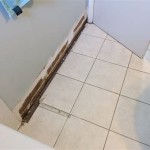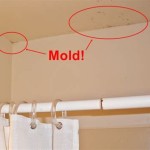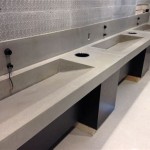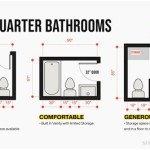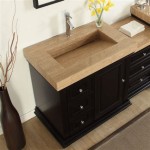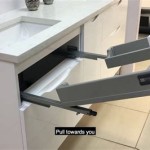What Is Best For a Bathroom Ceiling
The bathroom, often a small and highly functional space, presents unique challenges when it comes to construction and design. One of the most critical areas to consider is the ceiling. Bathroom ceilings are exposed to high levels of humidity, fluctuating temperatures, and potential water splashes. Selecting the appropriate material and construction method is essential for longevity, preventing mold growth, and maintaining the aesthetic appeal of the bathroom. This article explores various options for bathroom ceilings, outlining their advantages, disadvantages, and key considerations.
Understanding the Challenges of Bathroom Environments
Bathrooms are inherently moisture-rich environments. Showers, baths, and even handwashing contribute to increased humidity levels. This moisture can condense on surfaces, particularly the ceiling, creating a breeding ground for mold and mildew. Mold growth is not only unsightly but can also pose significant health risks, especially for individuals with allergies or respiratory problems. Moreover, prolonged exposure to moisture can damage ceiling materials, leading to warping, cracking, and eventual structural failure. Therefore, the ideal bathroom ceiling solution must be moisture-resistant, durable, and capable of withstanding the unique conditions present in this space.
Temperature fluctuations are another factor to consider. Hot showers and baths can dramatically increase the temperature of the bathroom, while cooler temperatures prevail when the space is not in use. These temperature swings can cause materials to expand and contract, potentially leading to cracks or other forms of damage. Furthermore, inadequate ventilation can exacerbate these issues, trapping moisture and hindering the drying process. Proper bathroom ventilation is crucial, but the ceiling material must also be selected with temperature fluctuations in mind.
Finally, potential water splashes and leaks from plumbing fixtures are constant threats in a bathroom. Even with careful use, water can splash onto the ceiling during showers or baths. Leaks from above, whether from plumbing or the roof, can also cause significant damage to the ceiling. A robust and water-resistant ceiling material can help mitigate these risks and prolong the life of the bathroom ceiling.
Exploring Popular Bathroom Ceiling Materials
Several materials are commonly used for bathroom ceilings, each offering distinct advantages and disadvantages. The selection process should consider factors such as cost, aesthetics, ease of installation, moisture resistance, and maintenance requirements.
Drywall (Gypsum Board): Drywall is a widely used material for ceilings throughout homes, including bathrooms. It is relatively inexpensive and easy to install, providing a smooth and paintable surface. However, standard drywall is not suitable for bathrooms due to its susceptibility to moisture damage. When exposed to humidity and water, drywall can absorb moisture, leading to swelling, sagging, and mold growth.
To make drywall suitable for bathroom use, moisture-resistant drywall, often referred to as "green board" or "blue board," is recommended. This type of drywall has a water-resistant coating that helps prevent moisture absorption. While more resistant to moisture than standard drywall, it is still not completely waterproof. It is essential to prime and paint moisture-resistant drywall with a high-quality, mold-resistant paint to provide additional protection. Even with these precautions, proper ventilation is crucial to prevent moisture buildup and potential damage.
Cement Board: Cement board is a highly durable and water-resistant material made from cement, sand, and reinforcing fibers. It is often used as a substrate for tile in wet areas, such as shower walls and floors. Cement board is an excellent choice for bathroom ceilings due to its resistance to moisture, mold, and mildew. It will not warp, crack, or rot when exposed to water, making it a long-lasting and reliable option.
However, cement board is heavier and more difficult to install than drywall. It requires specialized tools and techniques for cutting and fastening. Additionally, the seams between cement board panels must be properly sealed with cement board tape and thin-set mortar to prevent water penetration. While the initial cost of cement board may be higher than drywall, its superior durability and water resistance can make it a cost-effective choice in the long run, especially in high-moisture bathrooms.
Plaster: Plaster is a traditional ceiling material that offers good moisture resistance and a durable finish. It is made from a mixture of lime, sand, and water, applied in multiple layers over a lath substrate. Plaster ceilings can provide a smooth, seamless surface that is less prone to cracking than drywall. They also offer good sound insulation properties.
However, plastering requires skilled labor and can be more expensive than drywall installation. Plaster is also heavier than drywall and can be more difficult to repair. While plaster is inherently moisture-resistant, it is still important to ensure proper ventilation in the bathroom to prevent moisture buildup. Applying a mold-resistant paint can further enhance the ceiling's resistance to moisture and mold growth.
Wood Planks or Paneling: Wood planks or paneling can add warmth and character to a bathroom ceiling. They can be made from various types of wood, such as pine, cedar, or redwood. When properly sealed and finished, wood can be surprisingly durable in a bathroom environment. Cedar and redwood are naturally resistant to moisture and decay, making them excellent choices for bathroom ceilings. Wood planks can be installed horizontally, vertically, or diagonally, creating a unique and visually appealing look.
The key to using wood in a bathroom ceiling is proper sealing and ventilation. The wood must be thoroughly sealed with a waterproof sealant to prevent moisture absorption. Regular maintenance, such as reapplying the sealant, is also necessary to maintain the wood's integrity. Proper ventilation is essential to prevent moisture buildup and potential warping or rot. In addition, consider using a wood species that is naturally resistant to pests and decay.
PVC Panels: PVC (polyvinyl chloride) panels are a relatively new option for bathroom ceilings. They are lightweight, waterproof, and easy to install. PVC panels are available in a variety of colors, patterns, and textures, allowing for a wide range of design possibilities. They are also resistant to mold, mildew, and insects, making them a low-maintenance option for bathrooms.
PVC panels are typically installed using a tongue-and-groove system, creating a seamless and waterproof ceiling. They can be easily cut to size using common tools, and the panels can be fastened to furring strips or directly to the ceiling joists. While PVC panels are relatively inexpensive, their aesthetic appeal may not be to everyone's taste. Some may find the look of PVC panels to be too artificial or plasticky. However, for those seeking a waterproof and low-maintenance option, PVC panels can be a good choice.
Metal Ceiling Tiles: Metal ceiling tiles, particularly those made from aluminum or stainless steel, offer excellent moisture resistance and durability. They are often used in commercial bathrooms but can also be a stylish and practical option for residential bathrooms. Metal ceiling tiles are available in a variety of finishes, including plain, embossed, and perforated. They are typically installed in a suspended ceiling grid, allowing for easy access to plumbing and electrical wiring.
Metal ceiling tiles are resistant to mold, mildew, and insects. They are also easy to clean and maintain. However, they can be more expensive than other ceiling materials. Metal can also be prone to condensation, so proper ventilation is essential to prevent water damage. Additionally, some metal ceiling tiles can be noisy, especially if they are not properly secured to the ceiling grid.
Suspended Ceilings (Drop Ceilings): Suspended ceilings, also known as drop ceilings, consist of a grid of metal runners suspended from the ceiling joists, with individual tiles or panels placed within the grid. They are a popular option for both residential and commercial bathrooms due to their ease of installation and access to utilities above the ceiling. Several types of tiles can be used in a suspended ceiling, including mineral fiber tiles and metal tiles.
For bathroom applications, it is crucial to select tiles that are moisture-resistant. Mineral fiber tiles designed for bathroom use are available with a water-resistant coating. Metal tiles offer even greater moisture resistance. Suspended ceilings can also help to conceal plumbing, electrical wiring, and ductwork, creating a clean and uncluttered look. However, they can also lower the ceiling height, which may be a concern in smaller bathrooms.
Key Considerations for Selecting a Bathroom Ceiling Material
Choosing the best material for a bathroom ceiling involves weighing various factors. The following points outline some key considerations:
Budget: The cost of materials and installation is always a significant consideration. Some materials, like basic drywall with moisture-resistant paint, are relatively inexpensive, while others, such as cement board or specialized wood planks, can be more costly. It is essential to balance the upfront cost with the long-term durability and maintenance requirements of the material. A cheaper material that requires frequent repairs or replacement may ultimately be more expensive than a more durable, albeit pricier, option.
Moisture Resistance: This is arguably the most crucial factor. The bathroom ceiling must be able to withstand high humidity levels and potential water splashes. Materials that readily absorb moisture, such as standard drywall, should be avoided unless properly protected with a waterproof coating. Cement board, PVC panels, and metal ceiling tiles offer excellent moisture resistance and are ideal choices for bathrooms.
Ventilation: Even with a moisture-resistant ceiling material, proper ventilation is essential to prevent moisture buildup and mold growth. A properly sized and functioning exhaust fan can effectively remove excess moisture from the bathroom, reducing the strain on the ceiling material. The exhaust fan should be vented to the exterior of the house, not into the attic or crawl space.
Aesthetics: The ceiling should complement the overall design of the bathroom. Consider the color, texture, and style of the ceiling material when making your selection. Wood planks can add warmth and character to a bathroom, while metal ceiling tiles can create a modern and industrial look. PVC panels are available in a variety of colors and patterns, allowing for a wide range of design possibilities.
Ease of Installation: Some materials are easier to install than others. Drywall and PVC panels are relatively easy to install, while cement board and plaster require specialized tools and techniques. If you plan to install the ceiling yourself, consider your skill level and choose a material that you are comfortable working with. If you are hiring a contractor, be sure to get quotes from multiple contractors and check their references.
Maintenance: Consider the maintenance requirements of the ceiling material. Some materials, such as PVC panels and metal ceiling tiles, are easy to clean and require minimal maintenance. Others, such as wood planks, may require regular sealing and maintenance to prevent moisture damage. Choose a material that you are willing to maintain to ensure its longevity and appearance.
By carefully considering these factors, homeowners can select the best ceiling material for their bathroom, ensuring a durable, aesthetically pleasing, and healthy environment.

The Best Bathroom Ceiling Material Options Igloo Surfaces

What Is The Best Bathroom Ceiling Material Bathroombro

Creative Bathroom Ceiling Ideas For Your Home Renovation

15 Best Bathroom Ceiling Material Amazing Bathrooms Cladding

5 Bathroom Ceiling Material Ideas For Solid Functionality And Great Appeal Groysman Construction Remodeling

Bathroom Ceilings What Works Best

The 6 Best Bathroom Ceiling Materials To Complete Your Makeover Decorative Tiles Inc

The 6 Best Bathroom Ceiling Materials To Complete Your Makeover Decorative Tiles Inc

15 Trendy Bathroom False Ceiling Design Ideas Of 2024 For N Houses

15 Best Bathroom Ceiling Material Panels Materials
Related Posts


